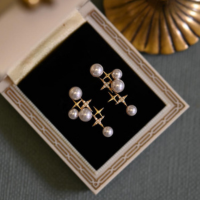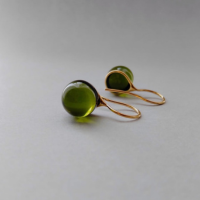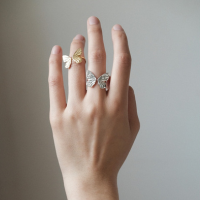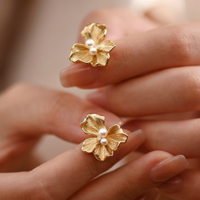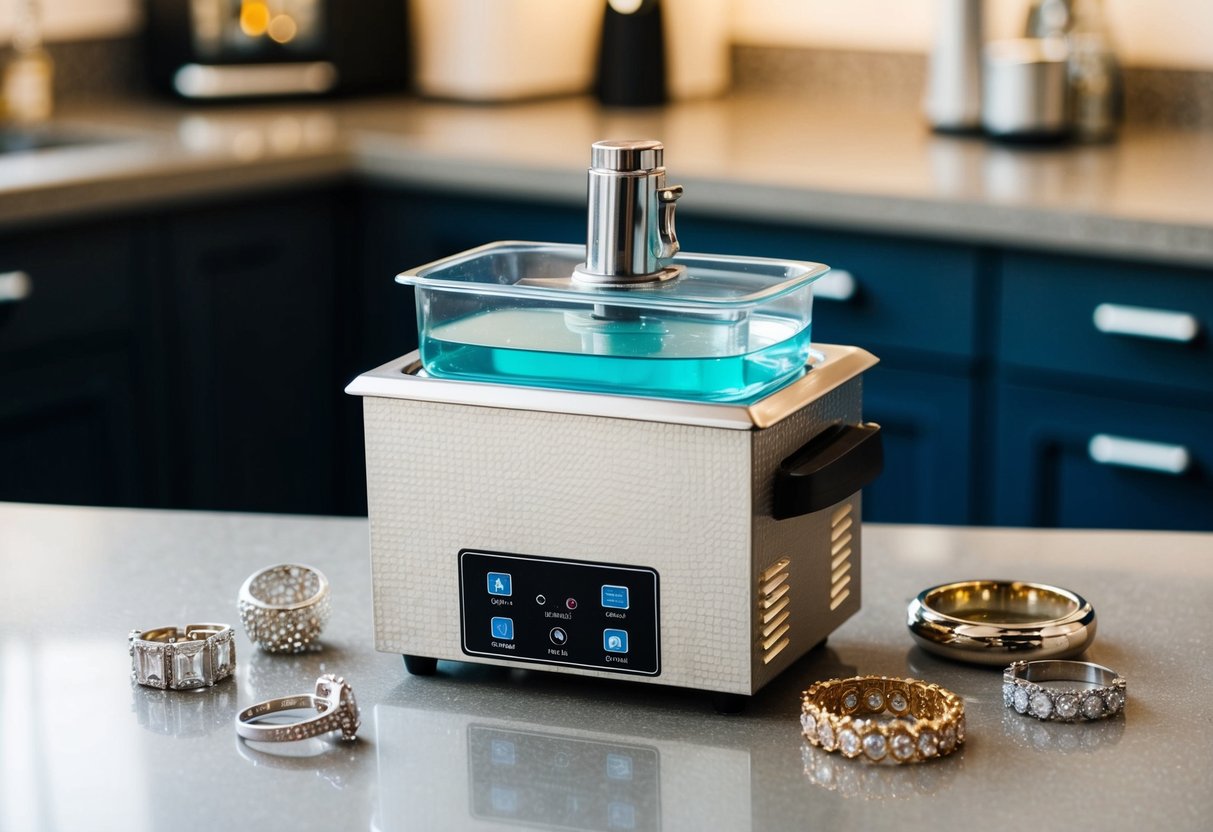
What Liquid to Use in Ultrasonic Cleaner for Jewelry
Check out our personalized jewelry collections! (kids drawing jewelry, coin jewelry, wire jewelry, fingerprint jewelry, handwriting jewelry, and more)
Choosing the right liquid for an ultrasonic cleaner can keep our jewelry sparkling like new. The best choice for most jewelry types is a mild dish soap mixed with water. This solution is gentle on our precious items yet strong enough to remove dirt and oils. Cleaning with care ensures our gems and metals shine brightly.
Different pieces may need specific solutions for safe cleaning. For instance, gemstones like pearls and opals might require extra caution. We must always ensure the liquid doesn't harm delicate stones.
Keeping our ultrasonic cleaner in top shape is important. Following simple instructions and regular maintenance helps preserve the life of our jewelry. When cared for properly, these machines are a wonderful addition to any jewelry lover's toolkit.
Key Takeaways
- Use mild dish soap and water for most jewelry.
- Be cautious with delicate gems like pearls.
- Regular maintenance keeps the cleaner effective.
Overview of Ultrasonic Cleaners
Ultrasonic cleaners are tools that help us clean our jewelry efficiently. They use sound waves to remove dirt and grime from delicate items, making them shine like new. Learning how these machines work and their benefits for jewelry care is essential for anyone who loves their jewelry and wants to keep it sparkling.
Principles of Ultrasonic Cleaning
The magic of ultrasonic cleaners lies in sound waves. These waves create tiny bubbles in a cleaning solution. When the bubbles burst, they create a gentle force that lifts away dirt. This process is called cavitation.
Jewelry, with its intricate designs, can be tough to clean by hand. The ultrasonic cleaner reaches small crevices you might miss, ensuring a thorough clean. This method is gentle enough not to damage fragile components like stones or settings, making it ideal for many kinds of jewelry.
Different types of jewelry may require specific cleaning solutions. We must ensure our solution is safe for the materials to avoid damage. Always follow the manufacturer's guidelines carefully to maintain the jewelry’s beauty.
Benefits for Jewelry Care
Using an ultrasonic cleaner brings several benefits. First, it saves us time. Instead of scrubbing manually, we can simply place our jewelry in the cleaner and let it do the work. This leaves more time to enjoy our sparkling pieces.
Another benefit is the ability to clean multiple items simultaneously. We can place several pieces of jewelry in the cleaner at once. This efficiency is perfect for those who own several items and want them all to look their best.
Ultrasonic cleaners also extend the life of our jewelry. Regular, gentle cleaning helps maintain the integrity of metals and gems, ensuring they last longer. Easy maintenance keeps our cherished pieces looking vibrant and new for years to come.
Types of Jewelry Safe for Ultrasonic Cleaning
Jewelry made from certain metals and gemstones can handle ultrasonic cleaning well. We should take care to choose materials and items that won't get damaged.
Materials and Gemstones
Many metals like gold, platinum, and stainless steel are safe for ultrasonic cleaning. They can endure the vibrations without getting scratched or worn. When it comes to gemstones, diamonds, rubies, and sapphires are generally safe. These stones are hard and unlikely to be harmed.
Some materials should never go in an ultrasonic cleaner. For example, pearls, opals, and similar stones are too soft and can get damaged. Stones treated with oils or dyes shouldn't be cleaned this way either, as they may lose their enhancements.
Common Jewelry Items
Rings and bracelets made from durable metals and hard gemstones are excellent choices for ultrasonic cleaning. We often see engagement and wedding rings as perfect candidates because they frequently feature diamonds and durable metals. Chains and necklaces, if they're made from gold or platinum, can also withstand ultrasonic cleaning.
It's important not to clean jewelry that includes glued-on parts. The vibrations can loosen the adhesive. Watches with mechanical movements should also be avoided in ultrasonic cleaners. They might let water in, damaging the internal parts. Proper care will keep our jewelry sparkling and intact.
Preparing Your Jewelry for Cleaning
Before using an ultrasonic cleaner, we must take some steps to protect different types of jewelry. This includes checking each piece for issues and arranging them correctly in the basket.
Inspection and Pretreatment
We begin by checking each piece for any loose stones, damaged settings, or weak points. Paying attention here protects valuable pieces. If a stone feels loose, we should get it repaired before cleaning. It’s also wise to check the manufacturer’s guidelines for any specific cleaning warnings.
Pretreat any visible dirt or grime. Wipe away surface dirt with a soft, damp cloth, especially around intricate designs. If there are stubborn spots, gently use a soft brush or a toothpick to remove debris, focusing on delicate areas.
Arrangement in the Basket
Proper placement in the basket is key. We ensure pieces are not touching to prevent scratches. Use the hooks or separators if available. This is especially important for softer stones and metals.
Our jewelry should be positioned in a single layer at the bottom. Overlap can lead to damage. For small chains, we can coil them gently to avoid tangling. Never overcrowd, as it reduces cleaning effectiveness and increases the risk of harm to your beloved pieces.
Choosing the Right Cleaning Solution
When it comes to cleaning jewelry with an ultrasonic cleaner, the right solution can make all the difference. We need to explore commercial cleaning solutions, homemade mixtures, and consider important factors to ensure our jewelry shines.
Commercial Solutions
Commercial cleaning solutions offer a simple and effective way to clean jewelry. These products are specifically made for use in ultrasonic cleaners and are designed to remove dirt, oils, and tarnish from metals and gemstones. It's crucial to choose a product that is safe for the materials in your jewelry.
Most commercial solutions list the types of jewelry they work best with. Gold, silver, and gemstones all require different care. Some products are suitable for all jewelry types, while others are specialized.
Following the manufacturer's instructions for use and dilution is important. This allows optimal cleaning without damage. Commercial solutions are convenient and provide reliable results for many of our needs.
Homemade Mixtures
Creating a homemade cleansing solution can be budget-friendly and effective. Many use simple ingredients like mild dish soap, water, and a small amount of ammonia. This mixture can lift oils and grime from jewelry.
Baking soda and vinegar are also popular choices, especially for silver. They help remove tarnish and restore shine. We should avoid using harsh chemicals or solutions that could damage soft stones or plated jewelry.
It’s always a good idea to test our solutions on a small area first. This ensures they are safe for our precious pieces. By using items we already have, we can easily maintain jewelry without buying special products.
Factors to Consider
When choosing a cleaning solution, material compatibility is key. Every type of metal and gemstone has its own needs. We need to ensure our solution won't damage our jewelry.
Allergies or sensitivities to certain chemicals might affect our choice. Opting for gentle solutions can prevent skin irritation. We also consider the condition and value of our jewelry. Antique or delicate pieces might need special care.
Lastly, time and convenience play a role. Commercial solutions save time but come at a cost. Homemade mixtures require more effort but are economical. Balancing these factors helps us pick the best solution for our jewelry.
Operating the Ultrasonic Cleaner
Using the ultrasonic cleaner the right way helps us achieve the best results for our jewelry. We need to pay attention to how we fill the device and determine the correct cleaning cycle duration.
Filling and Setting the Device
First, we need to choose the right cleaning solution for our jewelry. Once we decide, pour it into the ultrasonic cleaner's tank. Fill the tank properly without exceeding the maximum fill line. Ensuring the jewelry is fully submerged helps the solution work its magic.
After filling, it's important to select the right settings. Different materials may require different levels of ultrasonic power. We should check our cleaner's manual for guidance. Some devices may have preset modes, which can be handy for beginners.
Cleaning Cycle Duration
The duration of the cleaning cycle affects how well our jewelry is cleaned. Most jewelry items benefit from a cycle lasting 3 to 10 minutes. However, delicate pieces might require shorter times to avoid any damage. It’s a good idea to start with a short cycle and increase if needed.
Some ultrasonic cleaners have timers, allowing us to set precise cleaning times. We recommend checking the progress midway through the cycle. This way, we can decide whether our jewelry needs more or less time before the cycle ends.
Post-Cleaning Care
After using an ultrasonic cleaner, it's important to give your jewelry the best care possible. We’ll guide you on how to rinse, dry, polish, and store your pieces.
Rinsing and Drying
Once your jewelry is clean, we should rinse it thoroughly with water. This helps remove any leftover cleaning solution which can harm delicate pieces over time. Using a soft brush, gently scrubbing any residue on the surface ensures every nook is spotless.
For drying, it is best to use a soft, lint-free cloth. Patting each piece dry prevents water spots. Hanging or placing them on a clean towel until fully dry can also prevent tarnish and maintain shine.
Polishing and Storage
Polishing brings back the sparkle of our jewelry. We recommend using a soft polishing cloth specifically made for jewelry to enhance the shine without scratching. For items that need a little more shine, we might consider a gentle jewelry polish solution.
Proper storage is crucial to keep our jewelry in perfect condition. We should store pieces separately in a jewelry box or soft pouches to prevent scratches. It's wise to keep them in a cool, dry place away from direct sunlight and moisture, preserving their beauty for years to come.
Maintaining Your Ultrasonic Cleaner
Keeping our ultrasonic cleaner in good shape ensures it works effectively and lasts longer. Focusing on regular upkeep and proper handling of cleaning solutions helps maintain performance.
Regular Upkeep
To keep our ultrasonic cleaner running smoothly, we should clean the tank after each use. Removing leftover dirt and solution prevents buildup. It's important to inspect and clean the exterior using a soft cloth with a little detergent. We should also check for loose parts, like cables and connectors, to prevent any issues during operation.
Running an empty cycle with water every few weeks helps remove any lingering residues. This maintenance keeps the machine clean and efficient. We should also turn the machine off before doing any cleaning or inspections to ensure safety.
Solution Disposal and Replacement
Changing the cleaning solution regularly is essential. How often we need to do this depends on how dirty the items we clean are and how frequently we use the cleaner. After each session, letting the solution sit might cause it to degrade. Regular replacement ensures the best cleaning results for our jewelry.
We must properly dispose of old solutions. Many contain chemicals not suitable for regular drains. Check local disposal rules to avoid environmental harm. Disposing of these solutions according to guidelines keeps us safe and is environmentally responsible. By keeping fresh solutions ready, our jewelry always receives optimal care.
Frequently Asked Questions
Choosing the right liquid for an ultrasonic jewelry cleaner can enhance the cleaning process. Let's explore some common questions about keeping jewelry safe and shiny during cleaning.
Can I use a homemade solution in my ultrasonic jewelry cleaner?
We recommend caution with homemade solutions. Some mixtures can damage certain types of jewelry. It's important to ensure that the components in your solution are safe for the materials of your jewelry. Testing on a small item or seeking professional advice can be helpful.
What is the ideal cleaning solution for gold jewelry in an ultrasonic cleaner?
A mild ammonia-based solution or a specialized jewelry cleaner works well for gold. These solutions are gentle yet effective, ensuring that gold maintains its luster without any damage. Always follow the instructions on the cleaner for the best results.
Is it safe to clean silver jewelry in an ultrasonic cleaner, and what solution should I use?
Silver can be safely cleaned with an appropriate solution. A specialized silver cleaner or a mix of water and a small amount of detergent can work. Avoid solutions with high acidity to prevent tarnishing. Mild solutions usually offer the best balance for cleaning and preserving silver.
Are there any specific detergents recommended for use in ultrasonic jewelry cleaners?
There are several detergents specially formulated for ultrasonic cleaners. These are designed to effectively clean various types of jewelry without causing harm. It's best to choose products labeled for use in ultrasonic machines to ensure compatibility.
How can I effectively use my ultrasonic cleaner for delicate items like glasses or retainers?
We suggest using a gentle detergent or plain water for delicate items. Ensure items are properly secured in the cleaner to avoid damage. Avoid strong chemicals, which could affect the material integrity of delicate items. Ensure the cleaning time is short to minimize any potential risk.
What are the risks of using dish soap, like Dawn, in an ultrasonic jewelry cleaner?
Using dish soap in an ultrasonic cleaner can be effective but carries risks. Some soaps have additives that can tarnish jewelry or leave a residue. It could also foam excessively and affect the functionality of the device. Always dilute the soap if you choose to use it.

